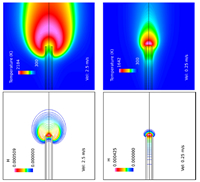Research highlights
Novel stability concept in miniaturized jet flames
Micro-engines and miniature combustion devices require carefully-designed micro-burners to produce stable miniature jet flames. The size of the burner leads to a strong interaction between the tip of the burner itself, the flame, and the gases in the air inside the burner. Flame stability problems are common because the burner itself can act as a heat sink, meaning the flame gradually dissipates energy before eventually going out.
In an attempt to verify the best conditions for generating steady flames, Yuji Nakamura (Toyohashi University of Technology) and Akter Hossain (Hokkaido University) examined numerically the stability of miniature hydrogen jet diffusion flames inside micro-burners made from different materials1.
The researchers investigated the gaseous components of the air surrounding the flame, as well as heat transfer within the solid parts of the burner itself. Numerical modelling helped Nakamura and Hossain determine the thermal and chemical characteristics of the jet flames resulting from different fuel ejection velocities, and thus assess flame stability.
A burner made from titanium, a relatively poor conductor of heat, provided the hottest, yet stable flame. The team believe the use of low thermally conductive burner material created a unique flame structure brought on by heat recirculation, which also enhanced reactivity within the burner. Pre-heating the fuel flow and adding oxygen to it stabilized the flame still further. It is important to reveal the fact that unique flame structure is established and even modified by adopting various burner materials taking advantage of thermal interaction to lead excess-enthalpy combustion.
- Reference:
- A. Hossain and Y. Nakamura.
- Thermal and chemical structures formed in the micro burner of miniaturized hydrogen-air jet flames.
- Proceedings of the Combustion Institute (2015)
- http://dx.doi.org/10.1016/j.proci.2014.08.008

Yuji Nakamura

Enlarge Image
Fig1:2-D temperature and mass fraction of H-atom distributions for different fuel ejecting velocities ((a) uin = 2.5 m/s and (b) uin = 0.25 m/s) over titanium burner.

